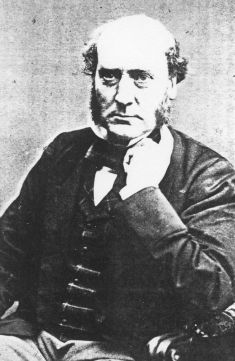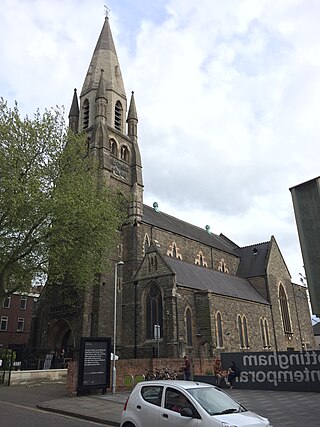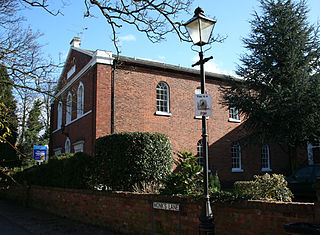
Sir George Gilbert Scott, largely known as Sir Gilbert Scott, was a prolific English Gothic Revival architect, chiefly associated with the design, building and renovation of churches and cathedrals, although he started his career as a leading designer of workhouses. Over 800 buildings were designed or altered by him.

Nantwich is a market town and civil parish in the unitary authority of Cheshire East in Cheshire, England. It has among the highest concentrations of listed buildings in England, with notably good examples of Tudor and Georgian architecture. It had a population of 14,045 in 2021.
The year 1803 in architecture involved some significant architectural events and new buildings.

Thomas Worthington was a 19th-century English architect, particularly associated with public buildings in and around Manchester. Worthington's preferred style was the Gothic Revival.

High Pavement Chapel is a redundant church building in Nottingham, Nottinghamshire, England. It is now the Pitcher and Piano public house and is Grade II listed. It was built as, and for most of its existence operated as, a Unitarian place of worship.

Dissenting Gothic is an architectural style associated with English Dissenters - Protestants not affiliated with the Church of England. It is a distinctive style in its own right within Gothic Revival architecture that emerged primarily in Britain, its colonies and North America, during the 19th century.

The Primitive Methodist Chapel is a former Primitive Methodist church on Welsh Row in Nantwich, Cheshire, England. Built in 1840, it is listed at grade II. The chapel closed in 2001, and the building has been partially converted to residential use.

The Wesleyan Methodist Church, also known as the Wesleyan Chapel, is a former Wesleyan Methodist church on Hospital Street, Nantwich, Cheshire, England. Built in 1808, a new façade was added in 1876. The church then seated over a thousand, and was the largest Nonconformist place of worship in the town in the 1880s. It is listed at grade II. The church closed in 2009, after the congregation moved to the former Methodist schoolrooms opposite.

The Congregational Chapel, also known as the Independent Chapel, is a former Congregational or Independent church in Nantwich, Cheshire, England. It is located on Monks Lane, now a pedestrian walkway, opposite the Dysart Buildings and immediately north east of St Mary's Church. Built in 1841–42, it is listed at grade II. The chapel closed in the late 20th century, and the building has been converted to residential use.

The Warburton Lectures are a series of theology lectures held in Lincoln's Inn, London. They were established in 1768 with money given by William Warburton, and were intended to bring young divines to the notice of London audiences. The set topic was the proof of Christianity through prophecies.
Eddowes Bowman, was a dissenting tutor.
John Eddowes Bowman the Elder was a British banker and naturalist.
John Eddowes Bowman the Younger (1819–1854) was an English chemist.
Joseph Stretch Crowther was an English architect who practised in Manchester. His buildings are mainly located in Manchester, Cheshire and Cumbria.
Philip Harwood was an English journalist and Unitarian minister, known as the editor of the Saturday Review.

Sweetbriar Hall is a timber-framed, "black and white" mansion house in the town of Nantwich, Cheshire, England, at 65 and 67 Hospital Street. It has been designated by English Heritage as a Grade II listed building.
John Wallen (1785–1865) was a 19th-century British architect and surveyor. He was the principal quantity surveyor in the City of London during the 1830s. Many of his former students, such as Edward I'Anson went on to have notable careers.

James Hall was an English antiquary, historian and schoolteacher, best known for his history of the Cheshire town of Nantwich, which remains among the principal sources for the town's history. He also edited accounts of the English Civil War and documents relating to Combermere Abbey. Another work on the history of Combermere Abbey, Newhall and Wrenbury was never published; its manuscript has been lost. Hall is commemorated in Nantwich in several ways, including a street named for him.

Mill Hill Chapel is a Unitarian church in Leeds, West Yorkshire, England. It is a member of the General Assembly of Unitarian and Free Christian Churches, the umbrella organisation for British Unitarians. The building, which stands in the centre of the city on City Square, was granted Grade II* listed status in 1963.












